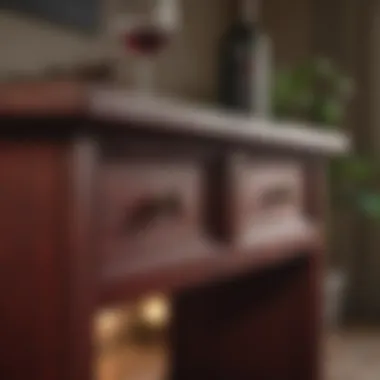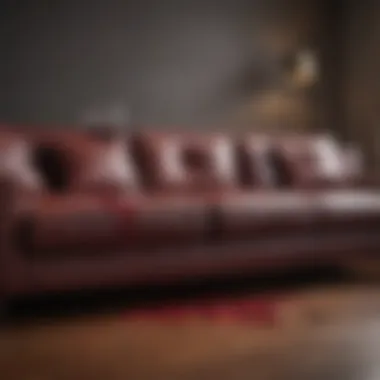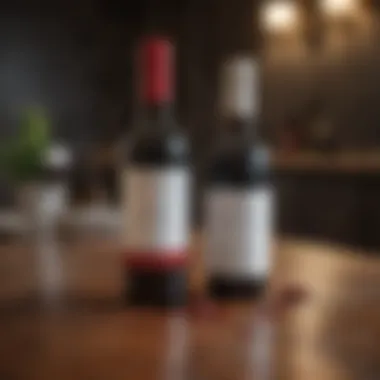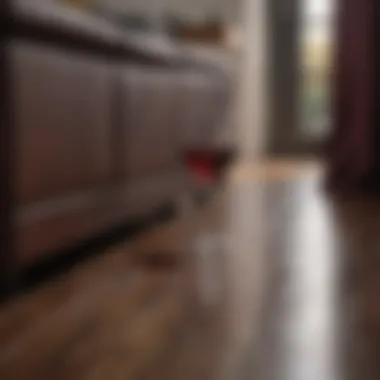Effective Methods to Remove Red Wine Stains from Furniture


Intro
Red wine stains on furniture can be both frustrating and challenging. The deep, rich color of red wine can easily seep into the fabric or finish of any furniture piece, leaving a mark that may seem permanent. Knowing how to effectively tackle these stains not only saves money on professional cleaning services but also preserves the integrity of your beloved furniture. In this guide, we will delve into the composition of red wine stains, immediate actions, various cleaning solutions, and practical tips that are essential for homeowners and design enthusiasts alike. Understanding the nuances of different materials allows one to take the right approach tailored to the specific surface.
Understanding Red Wine Stains
Red wine possesses tannins, pigments, and acids that can cause significant discoloration if not dealt with properly. The longer the wine remains on the surface, the deeper the stain will embed into the fibers or finish. Thus, timely action is crucial. Moreover, not all furniture is made from the same materials. For instance, the methods used on upholstery will differ significantly from those used on wood or leather.
Design Inspiration
When considering furniture that is more susceptible to staining, understanding design trends and color palettes can help in choosing pieces that are both stylish and practical.
Trending Styles
Selecting furniture with darker hues or patterned fabrics can be valuable strategies for minimizing the visibility of red wine stains. Rich colors like navy or charcoal gray can serve as a camouflage for potential stains. Similarly, textured fabrics can obscure minor blemishes more effectively than smoother textures.
Color Palettes
In the context of home design, integrating complementary colors around the space will direct focus away from potential stains. For instance, using lighter tones for walls and darker for the furniture can create a balanced aesthetic. Understanding how different colors interact in a space helps in planning for potential mishaps with red wine.
Practical Tips
Taking steps to protect and maintain your furniture not only prolongs its lifespan but also reduces the chances of permanent staining.
Maintenance & Care
Regular cleaning and treatment of surfaces can prevent stains from becoming ingrained. Utilizing protective sprays, especially on upholstery or wooden surfaces, can create a barrier against spills.
Suggested Protection Methods:
- Use fabric protectors designed for upholstery.
- Apply sealants for wooden surfaces to resist moisture.
- Regularly vacuum to remove debris and prevent staining.
Budgeting & Planning
When planning your purchases or renovations, consider the long-term maintenance costs of your furniture choices. Investing in high-quality materials that resist staining may be more cost-effective over time, even if the initial cost is higher. Structured budgeting around regular cleaning supplies can also ensure that you have the necessary tools on hand when those red wine mishaps occur.
"Preventive measures can significantly lessen the stress of unexpected staining, ensuring that your furniture remains attractive and functional."
In summary, a comprehensive understanding of how to approach red wine stains can empower homeowners and design enthusiasts alike. From the immediate response to the strategic choices in furniture design, every aspect contributes to preserving the visual appeal and functionality of your furnishings.
Understanding Red Wine Stains
Red wine stains present a unique challenge for homeowners and anyone who entertains regularly. Understanding these stains is crucial because it allows individuals to employ the right techniques for removal, helping to maintain the integrity and appearance of their furniture. When one spills red wine, the reaction to the stain can have lasting effects on fabric and wood surfaces. Recognizing the nature of red wine stains ensures that you can act quickly and effectively, minimizing damage.
Chemical Composition of Red Wine
Red wine comprises several components that contribute to its vibrant color and flavor. The primary elements include water, ethanol, sugars, and tannins. The pigments, mainly from the skins of grapes, belong to a class of compounds called anthocyanins. This rich combination not only gives red wine its characteristic hue but also makes it a formidable opponent against cleaning efforts. When spilled, the tannins in the wine bind with fabric fibers and wood surfaces, which increases their potential for staining. In essence, knowing the chemical makeup of red wine can guide one in choosing the most suitable cleaning method.
Why Red Wine Stains are Challenging
Red wine stains are problematic for several reasons. First, the deep pigments present in red wine penetrate surfaces quickly. Oily or waxy finishes on wood can trap these pigments, making them harder to remove. Second, the acidity of red wine can affect colors and finishes of certain fabrics and paints on furniture. Third, many cleaning solutions may not be effective against tannin-based stains, which often require specific treatments.
It is vital to approach red wine stains with an understanding of their unique characteristics. Knowing the composition can mean the difference between successful removal and permanent damage. As such, recognizing the need for prompt and appropriate action becomes essential.
Immediate Actions to Take


Red wine stains can be quite distressing, especially when they occur unexpectedly. Knowing how to respond swiftly can greatly influence the ease of removal and the overall success. Immediate actions not only help minimize the stain's impact but also set the stage for effective cleaning procedures later. Taking prompt action can prevent the stain from setting, which is crucial for preserving the integrity of the furniture.
Assessing the Damage
Before any cleaning takes place, it's vital to assess the damage caused by the stain. Different materials react uniquely to stains, and a thorough evaluation will guide your cleaning strategy. First, determine the nature of the fabric, wood, or leather involved. Checking for colorfastness, structural integrity, and any existing damage will help in choosing the right cleaning method.
For example, on upholstered furniture, look for fraying threads or discoloration. In wooden surfaces, check for water rings or other stains that might influence your approach. Assessing the situation enables a more targeted treatment, minimizing potential harm during the cleaning process.
Blotting the Stain
Blotting is one of the most effective immediate responses to a red wine stain. This method allows you to absorb excess wine without spreading it further.
Materials Needed
To effectively blot the stain, you'll need the right materials. The essential items include a clean, dry cloth or paper towels, and if available, cold water or club soda.
- Key Characteristics: A clean cloth is soft, minimizing the risk of embedding the stain deeper into the fabric. Paper towels are excellent for quick absorption. Cold water or club soda helps in lifting the wine without introducing heat, which could set the stain.
- Benefits: Using these materials preserves the furniture and can make a significant difference in the cleaning outcome.
Technique Details
The technique of blotting involves a few simple steps but requires patience and care. Start by gently dabbing the stain with your chosen cloth or paper towel. Avoid rubbing, as this can damage the fibers of the fabric or the finish on the wood.
- Key Characteristics: Blotting must be done gently and continuously until no more wine is coming up. This conservative approach prevents further damage.
- Advantages: If done correctly, this technique can largely prevent the stain from setting, paving the way for further cleaning solutions.
Remember, an immediate response can significantly impact the stain removal process, making prompt action essential in combating red wine stains.
Cleaning Solutions for Red Wine Stains
Cleaning solutions for red wine stains play a crucial role in effectively restoring furniture to its original state. These solutions can range from simple household items to specialized commercial products. The key is to act promptly and choose the right method based on the type of furniture and the resources available. Each solution has its unique advantages, and understanding these can greatly benefit your stain removal efforts.
DIY Solutions
Baking Soda Method
The baking soda method utilizes a common household ingredient that is effective at absorbing moisture and odors. Applying a paste of baking soda and water directly onto the stain can draw out the wine. Its mild abrasiveness makes it suitable for various surfaces without causing damage. Many users favor this method due to its non-toxic nature, making it safe especially for homes with children and pets. However, it may take longer to work compared to chemical solutions.
Key Points:
- Non-toxic and safe
- Absorbs moisture effectively
- May require longer removal time
Vinegar and Dish Soap Method
This method combines vinegar's acidity with the grease-cutting properties of dish soap. Mixing these two components creates a powerful solution to tackle red wine stains. The vinegar helps neutralize the wine's pigments while the dish soap aids in breaking down any oily residues. This combination is popular among homeowners due to its easy accessibility and effectiveness. However, it can have a strong smell, which might deter some users.
Key Points:
- Accessible ingredients
- Effective stain neutralization
- Strong odor during application
Salt and Water Method
Salt is another great option for combating red wine stains, particularly on fabrics. Salt works by absorbing the liquid from the stain, making it easier to lift. When mixed with water, it forms a paste that can be applied directly onto the stain. This method is favored for its simplicity and immediate approach. The downside is that it can leave a residue that may require further cleaning.
Key Points:
- Simple and quick application
- Absorbs wine effectively
- Possible residue left after cleaning


Commercial Stain Removers
Commercial stain removers offer a plethora of options specifically designed for tackling tough stains. These products are formulated with ingredients that target wine pigments, breaking them down more efficiently than most DIY solutions. Homeowners often turn to these products due to their speed and convenience, especially in cases of severe staining. It's essential to read labels carefully to ensure compatibility with your furniture material.
Types of Stain Removers
Commercial stain removers come in various formats, including sprays, foams, and wipes. Each type caters to specific needs and situations. Spray solutions, for instance, are ideal for larger areas, while wipes provide precision for small spots. Their ease of use and effectiveness makes them a popular choice for quick clean-up. However, some options may contain harsh chemicals, which can be a concern for users looking for eco-friendly solutions.
Key Points:
- Available in multiple forms
- Designed to target specific stains
- Potential chemical concerns
Best Products for Furniture
Identifying the best products for cleaning red wine stains from furniture involves considering effectiveness, surface compatibility, and user safety. Options like Folex Carpet Spot Remover and OxiClean MaxForce are often recommended due to their extensive use and positive reviews. These products generally offer strong cleaning power while being safe for various surfaces. Users should still verify suitability for their particular furniture type.
Key Points:
- Effective and well-reviewed products
- Safety for different surface materials
- Importance of verification before use
In the battle against red wine stains, having the right cleaning strategy is essential. Whether opting for a DIY approach or utilizing commercial products, understanding their unique properties will significantly enhance your stain removal success.
Methods for Different Types of Furniture
Removing red wine stains requires tailored approaches based on the material of the furniture. Different materials react uniquely to various cleaning methods. Understanding these nuances is crucial for effective stain removal. Each type of furniture may demand a specific technique or product for optimal results. Not addressing the material appropriately can lead to further damage.
Removing Stains from Upholstered Furniture
Fabric Types and Considerations
Upholstered furniture can consist of various fabric types, such as cotton, polyester, or blends that can affect cleaning methods. Cotton is favored for its durability and comfort. Polyester is stain-resistant and easy to clean. However, some fabrics can be more delicate. For example, silk can be prone to damage from harsh cleaners. Recognizing the characteristics of these fabrics is essential for selecting the right cleaning technique. This awareness helps avoid further deterioration of the upholstery.
Cleaning Process
The cleaning process for upholstered furniture often involves specific techniques. Start with gentle blotting to absorb the red wine. Avoid scrubbing, as it can spread the stain. Then, consider using a fabric-safe cleaner. Many effective cleaners focus on breaking down the tannins in red wine. This particular cleaning method is popular due to its efficiency and gentle approach. The key feature is its ability to preserve the fabric's integrity while addressing the stain.
Cleaning Wooden Furniture
Surface Protection
Protecting wooden surfaces is imperative for maintaining their aesthetic appeal. Wood is porous and can absorb liquids quickly, making it susceptible to damage from stains. A well-sealed finish can provide a barrier against stains. It is vital to choose the right sealant based on wood type. This protective measure is beneficial since it reduces the likelihood of staining. If a spill occurs, the clean-up process is simpler with a protective finish.
Recommended Techniques
Cleaning techniques for wooden furniture often include using mild cleaners and soft cloths. It is vital to dampen the cloth instead of soaking it. This method prevents excess moisture from seeping into the wood. For stubborn stains, a paste made from baking soda and water may be helpful. This approach is a popular choice due to its effectiveness on wood surfaces. However, one must test any cleaner in an inconspicuous area first to avoid damage.
Dealing with Leather Furniture
Caution with Leather
Leather requires special care, as it is sensitive to both moisture and harsh chemicals. Using excessive water can lead to water spots, while strong cleaners can strip the finish. Therefore, cautious approaches are necessary when dealing with red wine stains on leather. Recognizing the importance of gentle methods is vital for maintaining leather's quality and appearance over time. A light hand can go a long way in preserving the material.
Specialized Cleaning Products
Using specialized cleaning products designed for leather can provide targeted solutions without harming the material. These products often contain moisturizing agents, which help maintain the leather's suppleness. They are beneficial as they can simultaneously clean and condition the leather. However, it is important to follow the manufacturer's instructions for application. Relying on these products can significantly reduce the risk of damage during the cleaning process.


Preventive Measures
Preventive measures are crucial for maintaining the integrity of furniture against red wine stains. Understanding how to protect your items before an incident occurs can save homeowners a great deal of time, effort, and expense. The ramifications of neglect can lead to permanent damage, requiring costly repairs or replacements. Preventive strategies can provide an effective defense, allowing for enjoyment without worry.
Applying Protective Finishes
Applying protective finishes is an effective way to create a barrier against potential stains. Products such as sealants or varnishes can be beneficial, especially on wooden surfaces. These finishes help to repel liquids, preventing red wine from penetrating the surface and causing sustained damage.
Using a suitable product tailored to the specific type of furniture material is important. For example, a polyurethane finish is often recommended for wooden furniture since it provides durability and resistance to moisture. When applying a protective finish, ensure the surface is clean and dry. The application should be even and thin, allowing it to dry fully before use.
Regular maintenance is essential to keep the protective layer intact. Reapplication may be necessary over time, especially in areas prone to spills or heavy use. This proactive approach reduces the risk of stains and prolongs the life of the furniture.
Using Tablecloths and Coasters
Tablecloths and coasters play an important role in protecting furniture from red wine stains. By implementing a simple practice, homeowners can significantly reduce the likelihood of a stain occurring. Tablecloths create a barrier between the wine and the surface, absorbing initial spills and splashes. Choosing a fabric that is easy to clean is advantageous for quick recovery.
Coasters serve a dual purpose; not only do they prevent surface contact, but they also serve as a reminder for guests to be mindful of their beverages. When hosting, consider the material of the coasters—porcelain or cork options can absorb spills effectively.
When to Call a Professional
Dealing with red wine stains can be a frustrating experience. Many homeowners attempt to tackle these stains themselves, believing that a quick DIY solution will suffice. However, there are circumstances when it is wiser to contact a professional. Knowing when to make this decision can save not only your furniture but also your time and effort.
Factors to consider include the material of the furniture, the extent of the stain damage, and whether previous attempts at cleaning have failed. Professional cleaners have access to specialized tools and products that can remove even the most stubborn stains effectively.
Furthermore, attempting to clean complex materials, such as fine fabrics or delicate wood furniture, without the right knowledge may exacerbate the initial problem. There is also a risk of causing permanent damage to the surface if inappropriate methods or substances are utilized.
Signs of Permanent Stains
Determining whether a stain is permanent can be challenging. Here are some signs to look for:
- Discoloration That Lingers: If the red wine stain does not lighten after several cleaning attempts, it may have set into the fabric or wood.
- Loss of Texture: Stains that cause changes in texture can indicate deeper saturation that may not be salvageable.
- Dulling of Finish: On wooden surfaces, a stain that dulls the finish rather than merely changing the color is often irreversible.
- Unpleasant Odor: Sometimes, trapped moisture from spills like red wine can lead to odors. If scent persists despite cleaning, it signals the need for professional help.
Being attentive to these signs can help you make a prompt decision.
Professional Cleaning Options
When the need for professional intervention arises, several options exist.
- Dry Cleaning Services: Many upholstery cleaners specialize in dry cleaning fabrics, which can be effective for upholstered furniture.
- Specialized Stain Removal Services: Some companies focus solely on stain removal and can deal with challenging cases efficiently.
- Wood Restoration Experts: For wooden furniture, professionals in restoration can assess and apply the right techniques to restore the piece.
- Leather Specialists: If the stained furniture is leather, look for professionals who specifically handle leather upholstery to avoid further damage.
Epilogue
In considering the comprehensive approach to cleaning red wine stains from furniture, one must acknowledge the significance of timely action and appropriate methods. From immediate response techniques to using a variety of cleaning solutions, each step plays a crucial role in preserving the aesthetic and functional integrity of the furniture. Understanding the unique challenges presented by different materials allows homeowners to tailor their methods effectively.
This article stresses the importance of addressing stains promptly. Red wine, with its rich pigmentation, can quickly set into fabrics and wood, leading to irreversible damage if left untreated. Knowing how to act helps mitigate these risks.
Furthermore, a wealth of solutions, both DIY and commercial, provides options that cater to various preferences and circumstances. A proactive approach, involving preventive measures, can significantly reduce the likelihood of future stains.
Overall, furniture maintenance deeply impacts the ambiance of living spaces, making it essential for homeowners, interior design enthusiasts, and party hosts to equip themselves with knowledge and tools to effectively combat red wine stains.
Recap of Key Points
- Understanding the Stain: Red wine contains tannins that contribute to its staining properties, necessitating prompt action.
- Immediate Actions: Blotting the stain promptly minimizes damage. Utilize absorbent materials to soak up excess liquid.
- Cleaning Solutions: Various methods, such as baking soda and vinegar combinations, offer effective, home-based responses. Commercial products also present viable options for stubborn stains.
- Material-Specific Techniques: Each furniture type, whether upholstered, wooden, or leather, requires specific cleaning processes to avoid further harm.
- Preventive Strategies: Implementing protective finishes can help maintain furniture and ease cleaning processes.
- Professional Help: Certain stains may warrant professional intervention when home remedies prove ineffective.
Encouragement to Act Quickly
It cannot be overstated how crucial it is to act swiftly when dealing with red wine stains on furniture. The initial moments after a spill are vital. The longer the stain sits, the more embedded it becomes, leading to greater difficulty in removal.
Adopting immediate actions, such as blotting, can greatly enhance the chances of stain elimination. Facing a red wine incident can be stressful, but prompt intervention lays the groundwork for successful cleanup. Resources and methods outlined in this guide empower individuals to take necessary actions with confidence.
In a world where appearance often reflects a home’s care, managing stains effectively is essential. The right approach not only conserves furniture but enhances the overall quality of one’s living space. Remember, next time a wine glass tips, be ready to act.















